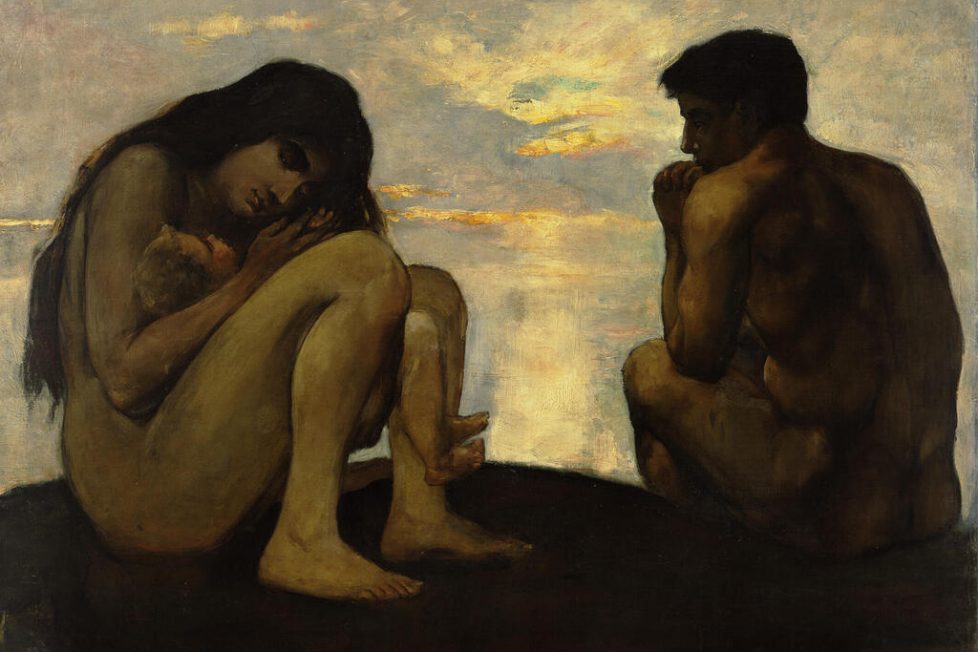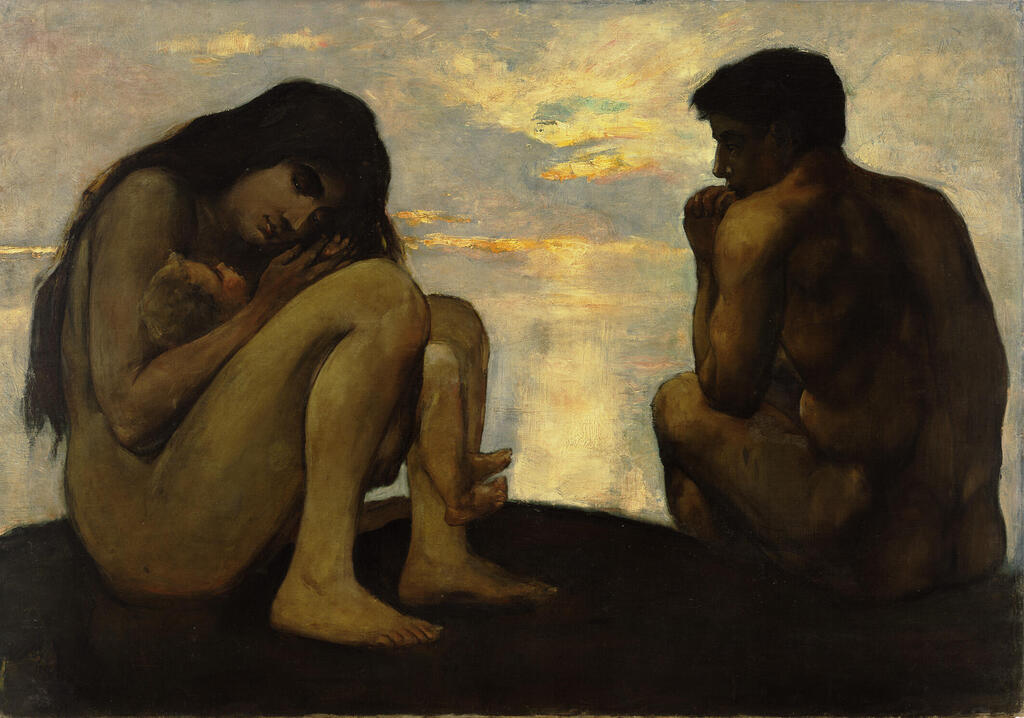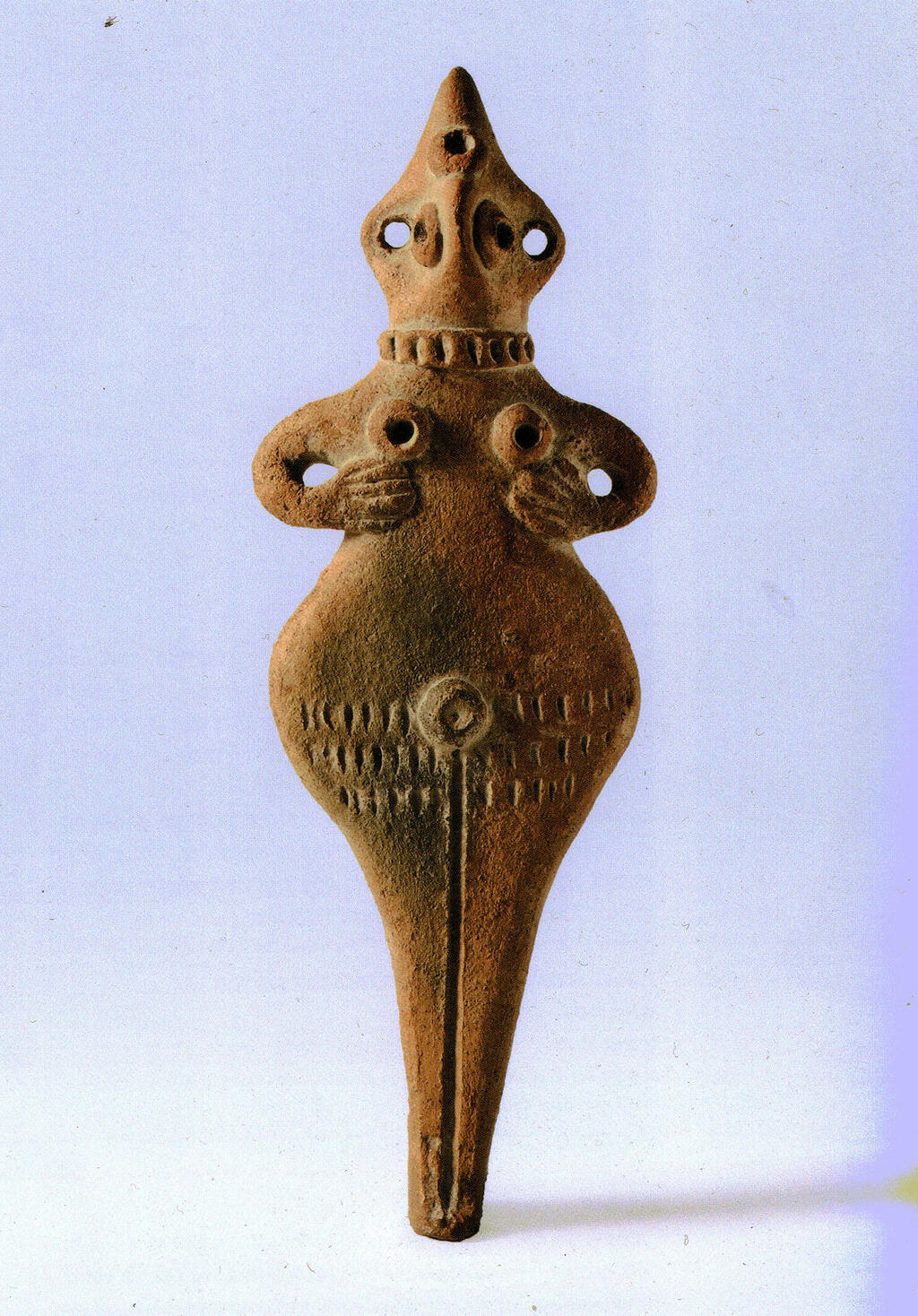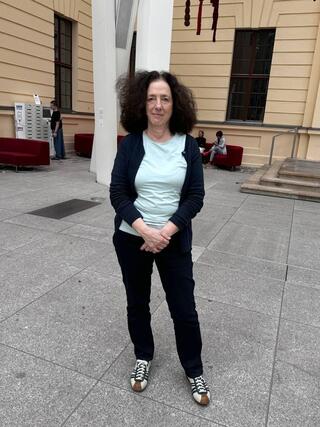The Jewish Museum Berlin presents: a journey to Jewish sex


At the entrance to each room in the exhibition “Sex: Jewish Positions” at the Jewish Museum Berlin, there are several quotes about sex, mainly by famous Jews. They are displayed on the walls in green letters and lead the visitor through the four themes of the exhibition: “Procreation and Pleasure,” “Desire and Control,” “Sexuality and Power,” and “Eroticism and the Divine.”
Adam and Eve with eldest son, 1896
(Photo: Jens Ziehe)
The idea for the exhibition and the preparations for it began two years ago, and it’s a joint initiative of the Jewish museums in Berlin and Amsterdam. “It’s a topic that intrigues the audience, and we thought it was a good way to make Judaism accessible to non-Jews,” says Miriam Goldmann, the exhibition’s curator. “It’s a universal theme that people can identify with and see themselves through. It’s an exhibition that builds a bridge between cultures and religions.”
Explain the title of the exhibition. It sounds like provocation at first.
“We worked on it together with our marketing department. A title like ‘Jews and sexuality’ is a bit boring because anything can be related to Judaism. So, sexuality yes, but it fits better with poses or opinions. We got the inspiration for the title from a book called ‘Halachic Positions’, which collected all the physical sexual positions mentioned in the Talmud and Halakha, detailing what is allowed and what is prohibited. Taboos and fantasies are an attraction, but we are not a sex museum. We cannot make too much provocation.”
Do you think that an attitude toward sexuality can define currents in Judaism?
“The Halakha is constantly moving forward. Who knows what will happen in 200-300 years? The attitude toward homosexual relations may also change. I don’t think it will happen so fast, but it is possible that progressive Jews will draw traditional Jews to follow their path. Things move, people change.”
The exhibition, which opened in mid-May and will remain available until October, spreads over 800 Sqm. on the first floor of the museum located in the German capital, which nowadays is hosting Euro 2024 – European football championship. It presents about 140 artifacts created by 50 artists. The works include texts from various sources, mainly the Halakha and the Talmud, video films, photographs, and paintings. The central theme of the exhibition engages in contradictions: traditional customs vs. progressiveness; regulation and religious dictation vs. changing cultural norms and emancipation.
“We’ve got a god for everything. The only thing we don’t have a god for is premature ejaculation… but I hear that’s coming quickly” (Mel Brooks)
The exhibition begins with a painting of Adam and Eve which involves the commandment to “be fruitful and multiply”, next to nudity pictures taken by an Israeli photographer, and it is meandering through video clips taken from the movie ‘Yentl’, sex toys for women, an orgasm scene taken from a Czech movie, huge photos of sexually unidentified couples portraying sexual acts, and a poem by I. L. Peretz about a Yeshiva student who was torn between his lust for women and his desire to study Torah. Next to the exhibits, there are detailed written explanations – about the Ketubah, the Mikveh, the Niddah laws, the obligation of consensual sex, and man’s obligation to please his wife.
In the section dedicated to LGBT, there’s a screening on the wall featuring stories of individuals who came out of the closet and wish to maintain an alternative sexual lifestyle and yet keep their Jewish faith. Here, there’s a moving conversation with a father who accepts, with great difficulty, his son’s coming out of the closet, wondering how to tell his grandson about his choice. Right in front of it, there are articles warning against Yetzer HaRa (tendency to sin and sexual urges) and against the temptations of women. On one screen, the TikTok Talmud influencer Miriam Anzovin is seen posting her Daf Yomi (daily folio) videos for her followers, incorporating feminist messages for the younger generation.
8 View gallery


A statue of fertility, Bronze Age
(Photo: Courtesy of the Haifa National Maritime Museum)
One of the rooms is dedicated to biblical taboos – forbidden intercourse between a man and a woman, incest and adultery – and how various taboos were already broken in the Bible, by Boaz and Ruth, King David and Bathsheba or Lot and his daughters.
The advantage of the exhibition lies in the multitude of different and colorful objects it displays, but this is also its disadvantage, which is not the exhibition organizers’ fault: while the artifacts concerning freedom and sexual liberation in the Jewish world are dynamic, having many forms, stimulate the imagination and the senses, and the visitors can’t get enough of them, the traditional orthodox objects, in contrast, consist only of ancient, uninviting, academic texts. I visited the exhibition three times, spending hours each time, and most of the visitors (about 80% percent of the visitors were women) did not spend time reading the texts.
“You have to understand that this is not our decision,” explains Goldmann, “there was an artifact by an Orthodox artist that we wanted to display, we contacted his art teacher and there was simply no way he would agree to present his work in such a place. So, we simply could not bring any artifact of this kind, although we really wanted to. On the other hand, this exhibition is not an amusement park, it is interesting but not entertaining, and it is also an intellectual challenge. There was a limit to the number of texts we could include.”
“The sexual organs are the most sensitive organs of the human being. They are not diplomats. They tell the truth ruthlessly” (Isaac Bashevis Singer)
The exhibition engages, among other things, in the involvement of Jews in the science of sexology at the beginning of the 20th century, mainly Sigmund Freud and Magnus Hirschfeld, and also deals with sex and the Holocaust (including the success in Israel of a series of books that dealt with the relationship between Nazi female prison guards and Jewish prisoners). You can also find board games about sex, designed by Dr. Ruth Westheimer.
At another location there is a scene from the movie “Everything You Always Wanted to Know About Sex (But Were Afraid to Ask)” by Woody Allen, in which a rabbi likes to be tied up while his wife eats a ham sandwich. The exhibition contains objects from the Bronze Age until today, and combines modern and contemporary art alongside ancient objects, while illustrating the different positions in Judaism regarding sex.
“This is a very enriching exhibition, it’s both educational and enjoyable,” says Johanna Weber, who came to visit the exhibition with her female life partner. On the one hand it shows, to my surprise, how much Judaism and Islam have in common in terms of sex, especially in relation to women who are seen as a model of temptation and Yetzer Ha’Ra, and precisely women are supposed to be modest in appearance to restrain men’s sexual urges.
On the other hand, this is a progressive exhibition that compliments Judaism, showing how dynamic it is, that it’s constantly moving, adapting itself to the changes in life. It’s amazing to see and experience the progress of Judaism in relation to women and LGBT; and it’s also amazing to know that alongside progress there are mitzvahs (laws) regarding purity, Mikveh and the prohibition of sexual activity with a menstruant.”
“For me, it’s really inspiring,” says her partner, Naomi, “We Germans know almost nothing about Judaism, and here we have access through something that is very intimate, but not holy, something that we also have to struggle and enjoy. For us sex is a natural thing, it has no contradictions or stipulations. Until now I could not think of a situation in which Jewish men and women live separately before they marry, and on their wedding night they have to realize something they know or learned nothing about. It’s fascinating.”
She adds: “In our eyes, the wedding night is considered a moment of pure, holy happiness, and I realize that for an entire sector this night feels like trauma, a trauma that involves a divine commandment. I generally feel here that the whole relationship between the Divine and Judaism and Israel, the belief in God, is very erotic, it’s a kind of a holy sex.”
Through dealing with norms, the different approaches, and the development of sex in the Jewish world, the exhibition shows that this topic is also subject to interpretation, like many other areas where Judaism contains countless opinions. It also shows that sexuality is not only a strict regulation, but also something that can be discussed and adjusted to the reality of life and to social changes.
Sexuality, according to the exhibition, has social and political relevance – and every generation, even in Judaism, seeks to question and investigate the traditional interpretations. It does not attempt to describe a revolution, but to show that even in the harsh world of Orthodox Judaism there are cracks through which progress can penetrate.
It dwells on the tension between the Mitzvah of procreation (“be fruitful and multiply”) and desire and pride, between religious duty and pleasure and lust. However, at times it collides with religion, and since it lacks living orthodox religious motifs, it cannot provide an orthodox answer to developments and innovations.
“Even though it has many traditional patriarchal pieces to it, Judaism is ultimately a pro-sex religion” (Esther Perel)
The exhibition naturally dwells on The Song of Songs, of which Rabbi Akiva said: “All the Scriptures are holy, but the Song of Songs is Holy of Holies.” The biblical scroll proves that lust, pleasure, love, physical longing, and yearning existed throughout Jewish history; it is also displayed in love poems between humanity and God, and in texts that talked about the spirituality involved in eroticism.
This is not an easy or fun exhibition, and it is not an exhibition about love. It includes quite a bit of pain, struggles over sexual freedom against what is considered taboo and against prohibitions set by the authorities and religious institutions. It dwells on the grief involved in concealment and suppression, versus the joy in creating new identities, and the struggle to allow non-traditional couples to raise children.
We spoke with the curator Miriam Goldmann in the museum courtyard, where above us hangs the work “Tumtum” by the Israeli artist Gil Yefman, who accompanies the exhibition. In Halakha, Tumtum describes a person whose sex organs are hidden or covered, someone whose genitalia cannot be distinguished as male or female. The work features a pinkish-purple ball consisting of small erect genitals, with or without pubic hair, pupils, breasts, and sperm. The work is intended to demonstrate the confusion, the hidden and the ambiguous surrounding the subject. “Both Abraham and Sarah were each a Tumtum” Goldmann quotes from the sayings of Chazal (the Sages), “this is an explanation as to why the couple were infertile for so many years.”
Goldmann studied Jewish studies and history in Freiburg, Jerusalem, and Berlin. Making Judaism accessible to non-Jewish public is her life’s mission. She has been a curator at the museum since 1999, two years before it was officially opened, and survived the scandal that surrounded it five years ago, when the museum was accused of anti-Israel activity. After the German parliament adopted a resolution condemning BDS as an antisemitic movement, the museum’s official Twitter account joined in criticizing the resolution – and following the sharp criticism toward the museum, the director of the museum at the time was forced to resign. That storm subsided after the museum’s new director, Hetty Berg, was appointed in April 2020.
How do you make a subject like sexuality in Judaism accessible to the public, and more so in Europe?
“It’s problematic because we don’t want to create voyeurism, but we do want to make the visitor feel a sense of identity and belonging, to understand that this is a universal issue, only here there is a Jewish twist to it. We wanted the visitors to say: ‘Wow, there is something here that looks like my life’ – and as a result it will slowly break down stereotypes about Jews. I pushed for a representation of pleasure, so the exhibition will not be only academic. So, how do you symbolize pleasure, through which object? It had to be sophisticated to appeal to more audiences.”
Will Muslims also come to the exhibition?
“I think it’s like with the Jews: those who are more open and less devout in religion, will come here. If Muslims enter the museum, they will also come to the exhibition.”
What differences do you see between Judaism and Christianity in relation to sexuality?
“It is clear that, in general, Christianity has much greater suppression of sexuality and sexual pleasure. Many people are surprised that it exists in Judaism, but on the other hand, people also do not expect Judaism to be so liberal on this issue. Most of the people who come here have no knowledge, and we have to provide them the most basic information.
“In Judaism, there are defined times and spaces for sex. There are laws of Niddah, which are related to cycles of time. On the one hand, the woman is reduced to someone who is only supposed to give birth and raise children, and on the other hand, she is the mainstay of the family, and she is highly praised. There are parts in Judaism where the woman is considered as equal (to men) and there are parts where there is no equality among them.”
 Exhibition Curator, Miriam GoldmanPhoto: Zeev Avrahami
Exhibition Curator, Miriam GoldmanPhoto: Zeev AvrahamiGoldmann points out that the exhibition also features stories about people who wanted to try a different kind of sexuality, but still wished to maintain their religious faith and practices. People are always looking for new ways to observe their religious belief, to reconcile their sexual and religious identities.”
How in your opinion, did Israel affect Jewish sexuality?
“You can live in Israel and celebrate everyone’s sexuality, and there is also such (sexual) tourism to Tel Aviv in which even Palestinians participate. Israel is a place in the Middle East where you can celebrate your sexual freedom. I also think that the kibbutzim led to a lot of openness and liberality on the subject.”
Was nudity a problem in the Jewish museum?
“Orthodox people don’t come here. But the nudity showcased in the museum is no more than what you see in German culture or media. Does woman’s modesty protect men from sexual urges? It’s like in Islam, do women have to cover up because of men’s sexual urges? A woman can and should decide which body parts she wishes to expose in public. This is also emancipation.”
